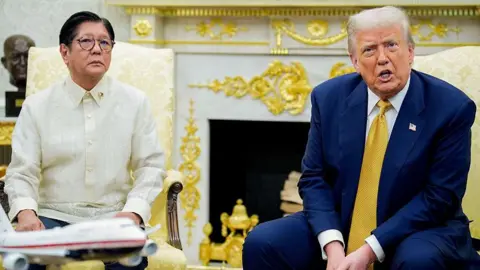In a recent announcement, US President Donald Trump stated that goods imported from the Philippines will be subjected to a hefty 19% tariff. This declaration came after a meeting with Philippine President Ferdinand Marcos Jr. at the White House on July 22, 2025. The new tariff is set to take effect as part of a broader trade agreement between the two nations, although specific details on the agreement’s scope remain scarce. Trump conveyed his sentiments about their discussions via social media, labeling it a “beautiful visit” and proclaiming the conclusion of a new trade deal.
While Trump’s announcement suggests a positive diplomatic engagement, the actual implications for the Philippines are significant. The introduction of a 19% tax means that the country is facing a burden heavier than the initial threats of tariffs made earlier. In April of the same year, Trump indicated a desire for sweeping global tariffs, which set the stage for ongoing negotiations with various countries.
Official comments from the Philippine Embassy in Washington D.C. are pending, as the government has yet to confirm the specifics of the arrangement discussed by Trump. This new tariff plan forms part of an ongoing Trump strategy aimed at recalibrating international trade relations, particularly as it relates to practices that he views as unfavorable to the United States. This strategy is not an isolated occurrence; Trump has pursued similar discussions with other nations, including formal agreements with countries such as the United Kingdom, China, and Indonesia. However, many of these agreements have kept high tariffs in play, alongside several unresolved contentious issues.
As discussions develop, the response from key partners like the European Union and Canada is critical. Trump’s administration faces potential upheaval as new tariffs threatening to come into force on August 1, 2025, loom large. Stakeholders in Europe have begun to contemplate retaliatory measures, raising concerns about an impending trade war. In Canada, Prime Minister Mark Carney expressed caution regarding the ongoing negotiations, although he was hesitant to set expectations for an agreement before Trump’s deadline. Carney emphasized that Canada will not accept a subpar deal, underscoring the complex dynamics in international trade negotiations.
Trump’s tariff agenda has already caused turbulence in financial markets, particularly since its initial announcement in April. The proposed tariffs could result in the highest duties the United States has seen since the early 20th century. After considerable backlash, Trump suspended some of the more aggressive plans; however, a broad 10% tariff remained. Additionally, higher duties were imposed on specific categories such as aluminum, steel, and automobile-related items. As markets stabilize and the US economy demonstrates resilience, Trump has reignited plans for increased duties, culminating in recent letters dispatched to various nations announcing significant new tariffs, including a proposed 20% charge specifically on Philippine goods.
Analyzing the broader economic landscape reveals that the Philippines maintains a modest trade footprint with the US, with approximately $14.2 billion worth of exports last year, encompassing car parts, textiles, and coconut oil. Nevertheless, as these tariff measures unfold, US companies are increasingly burdened by rising costs. For instance, General Motors has reported losing over $1 billion due to the tariffs in a three-month period, echoing sentiments from competitors such as Stellantis, who cited losses of approximately $349 million.
In conclusion, the imposition of a 19% tariff on Philippine goods is reflective of a broader strategy by the Trump administration to renegotiate terms of trade that they perceive as detrimental. While this new step may yield certain strategic advantages for the US, it also risks escalating tensions with international partners and fostering retaliatory actions. The developments in this trade discourse will undoubtedly have far-reaching implications for both the United States and the Philippines, meriting close observation as negotiations proceed.












